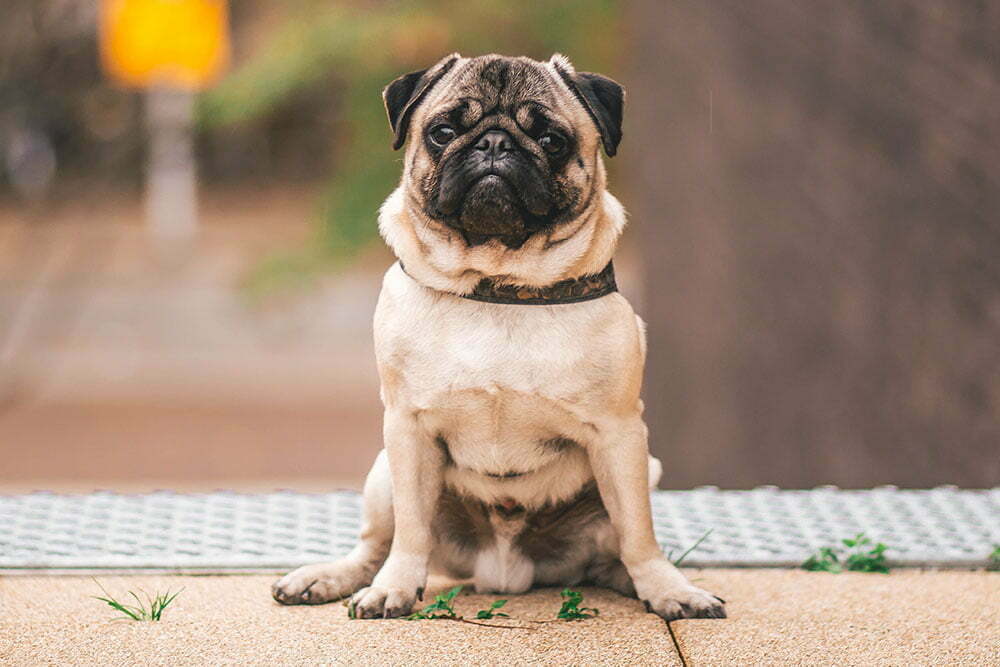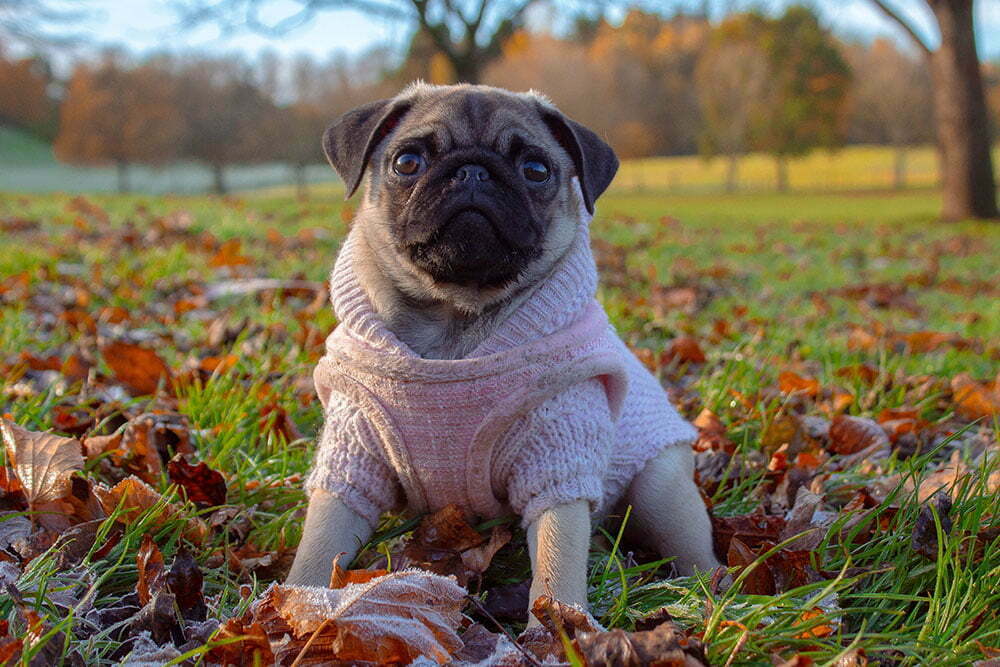Pugs are one of the most popular companion dogs today, perfect for families and single dog owners. They’re good-humored, not too timid or gnarly, and amusing to observe and be around.
So, if you’re thinking of adopting a pug, or simply want to know a little bit more about the popular breed, look no further.

This guide will take an in-depth look at the pug, including all the essential information relating to their temperament, health, trainability, and much more.
We’ll also take a look at the history of the breed, as well as a few fun facts and some of the frequently asked questions.
Key Facts And Appearance
On average, pugs have a lifespan of 12-15 years. This, of course, relies on them being in a healthy condition with a good, well-balanced diet and an appropriate amount of exercise.
According to experts, pugs should only need around 30-40 minutes of exercise per day.
Shorter walks and brief spells of playtime are ideal to ensure that their breathing problems aren’t exacerbated, while pugs seem to be at their adventurous and energetic best in short bursts.
Pugs can quickly become overweight and susceptible to a range of health problems if they don’t get enough exercise, so it’s essential that this is closely managed alongside their diet.
In terms of their appearance, pugs are instantly recognizable because of their small, stubby nature and distinctive features. They have large round heads, large protruding dark eyes, a curly tail, and a signature wrinkled brow.
Their fur coats are short, smooth, and glossy, and come in three different colors: silver, apricot-fawn or black. All three color variations are accompanied with a black face mask.
Pugs have what’s called a double coat. This effectively means that their short fur consists of two separate layers, one short and woolly in texture, and then their topcoat or ‘guard hairs,’ which are usually a bit longer. Having this double coat means that pugs tend to shed a lot, so brushing their coat on a regular basis is important.
For typical size and growth levels, the average male pug will grow up to 12 inches in height and weigh between 14-18lbs. Females, on the other hand, are slightly smaller and will typically grow up to around 10 inches.
Pugs are a toy breed, meaning there’s no specific breed standard for height. Therefore, some pugs will be smaller or bigger than the average range without having any major medical issues.
Temperament
Pugs are socially confident, curious dogs that are extremely adaptable and make for great house pets.
Whether you’re looking to introduce a pug puppy into a city-based apartment or a countryside farmhouse, they’ll be sure to provide you with an abundance of playfulness and affection.
They can tolerate and play nicely with other breeds of dogs but are also just as happy being the only pooch in the home. Just keep in mind that they’re sensitive creatures, so they love human attention more than anything and will feel heartsick if ignored.
While pugs may be playful and super excitable around meal times, they typically spend a lot of their day lazing around, living an extremely sedentary lifestyle. So, if you’re looking for a dog to cuddle up next to you on the sofa for long, lazy afternoons in front of the TV, a pug is as good a choice as any.
Due to their largely sedentary lifestyle, pugs are a popular breed amongst the elderly. This is because pugs will happily sit on the lap of an older person and be petted for an indefinite period of time. For many elderly people, especially those living in nursing homes, this is the closest and most personal contact they may experience.
In return, pugs love being in the company of the elderly. Their movement is slower and more pronounced; their voice is lower; their temperament calmer and more predictable – all of which help to put pugs at ease immediately.
Behavior Around Kids
Despite being a small breed of dog, pugs generally get on well with kids. A lot of the smaller breeds of dog don’t interact very well with young children and can sometimes be too full on, but pugs tend to keep their distance and have safe, playful interactions.
They certainly won’t wrestle with a child or bite them to assert their superiority, as would some other breeds.
The only time a pug may be aggressive towards a child is if the child is being openly aggressive towards it and the pug feels threatened by the situation. Other than that, children are completely safe in the company of a pug.
Health And Grooming
There are a number of health issues that pugs can typically suffer from. This is because the breed has experienced a fair amount of negative selection where the specimens were selected purely for their appearance.

We’ll now take a closer look at four of the most common health problems pugs tend to suffer.
Brachycephalic Airway Obstruction Syndrome
Due to their flatter faces and being a brachycephalic breed, the tissue in the nose and throat of pugs is squashed. This causes folds that can restrict the airways, making breathing considerably more difficult.
This explains why the majority of pugs are reluctant to exercise – and when they do, they often pant heavily – as it’s a constant struggle to take in enough oxygen. This problem is only intensified in warmer conditions.
Keratoconjunctivitis
This condition emerges when there’s a problem with the tear glands. Needless to say, a lack of tears can result in dry eyes, which are often sore and prone to infection.
If a pug suffering from keratoconjunctivitis is left untreated, there’s a possibility that scarring and pigmentation can occur – which may subsequently lead to blindness.
Hemivertebrae
This is a deformed backbone that is caused by the fusing of two or more vertebrae. As a result, the spine of a pug can become twisted and compressed, causing a wedged effect.
The most common signs of the condition include pain, incontinence, and hind limbs. While many dogs can live with hemivertebrae and not experience any of the more serious symptoms, severe cases require surgery to relieve the compression on the spine.
Excessive Weight Gain
As explained earlier, pugs are by no means active dogs. Therefore, they’re at a high risk of obesity, which every pug owner should be concerned about.
What’s more, pugs love their food and will happily overeat if left to their own devices. With all this in mind, it’s essential for your pug’s health and wellbeing to closely monitor their diet and exercise carefully.
In terms of grooming, pugs shed quite a lot and benefit from a thorough brushing 1-2 times per week. This is best achieved by using a rubber grooming mitt or a soft bristle comb. Furthermore, pugs should be bathed once every 3-4 weeks.
Closer inspections of their eyes, ears, and in between their wrinkles should be carried out at least a few times per week and cleaned if necessary. Just be mindful to choose a shampoo that’s relatively mild in scent, hypoallergenic, and that doesn’t irritate their skin.
It’s also worth cutting a pug’s nails regularly, particularly if they’re a city-based dog. This is because they won’t have as many opportunities to file them down themselves with limited digging spots.
Trainability
Pugs are people pleasers, so they’ll often be quite easy to train – especially for basic obedience training. Not only are they intelligent and social enough to understand what’s being asked from them, they’re also incredibly fond of treats.
As is the case with most young dogs, pug puppies will do almost anything for a tasty treat and some praise. Therefore, as a dog owner, you can use this to your advantage when it comes to training.
It’s worth noting, however, that pugs aren’t built to withstand any kind of advanced training. So, any action or command which requires them to respond with a significant amount of force or activity will prove challenging due to their small and stocky size.

Some aspects of advanced training can be incorporated into basic obedience work, but the limit is pretty low. Just remember that pugs are exclusively a companion dog, so it’s unrealistic to expect them to perform in a manner that they’re not meant to.
In terms of their potential to bite, pugs don’t ever do it in a harmful or aggressive way. They may go through a phase of nipping fingers or pieces of furniture when they’re younger, but this is mainly because of their abundance of energy and playful, social nature.
With some proper training when they’re still young, it should be easy enough to train them out of anything potentially problematic. So, any nipping that they do engage in, will gradually fade as they mature.
As with biting, pugs are rarely problematic when it comes to barking. They don’t tend to bark a lot, and when they do, it’s usually because of a situation in which they deem barking necessary.
Pugs are highly alert dogs so they make for great watchdogs. For example, warning their owner when a stranger is approaching the house.
History
While pugs are an increasingly popular breed of dog across the world, they originate from China.
Over 2,000 years ago, pugs and other flat-faced dogs, such as the Shih Tzu were coveted by royalty in the East Asian country and were often presented as gifts to subjects of the royal court.
Pugs were then brought to Europe in the 1600s and continued to be appreciated by those in upper-class society. Most notably, Queen Victoria II and her pug Basco. In fact, pugs were often depicted in many 18th-century portraits with their esteemed owners.
In terms of their original purpose, pugs – unlike many other short breeds – were not bred for their ability to hunt or their aptitude to capture vermin and small critters. Instead, pugs were bred solely for their calm temperament and adorable nature.
The ancestor of the pug is the now-extinct Molossus dog. This dog was first bred in Ancient Greece, which is proof of the regular dog trade between the Hellenic Republic and Ancient China.
Cost
On average, a pug will typically cost you somewhere in the region of $2,000. While some pugs may cost as little as $1,000 and less, the price for a well-bred pug from a reputable breeder is generally between $1,500 and $2,500.
Just be mindful that there are a few factors that may influence the final price of a pug. Some of the most common include the reputation of the breeder, as well as the color, age, and pedigree of the dog.
Fun Facts
- A group of pugs is known as a ‘grumble’
- Pugs are hugely popular on social media, with Doug the Pug – the self-proclaimed King of Pop
- Culture – boasting an impressive 3.9 million followers on Instagram
- The loudest snoring pug in the world has clocked a noise of 96 decibels which is just one decibel fewer than a jet plane flying a mile over your head
- There have been a large number of royal pugs, with owners including Prince William of Orange and Marie Antoinette.
- Pugs were known as “mopshounds” until the 1700s, however, the name “pug” was adopted after similarities were drawn between the breed and marmosets or “pug monkeys”
Frequently Asked Questions
Do Pugs Drool?
Pugs don’t tend to drool unless there’s something wrong such as an underlying health issue. While a little bit of drooling is normal for any dog, an excessive amount can be cause for concern.
Listed below are some of the potential health issues that can be responsible for excessive drooling in pugs:
– Tooth decay
– Tooth fracture
– Gum infection
– Injuries inside the mouth
– Poisoning
– Liver disease
Do Pugs Cause Allergies?
Yes, pugs aren’t a hypoallergenic breed, so if you’re allergic to dogs, pugs will likely trigger your allergies.
This is mainly because pugs shed a significant amount of fur, which in turn, facilitates the spread of dander and other allergens around your home. It’s worth noting, however, that these allergies can usually be controlled to a manageable level.
Do Pugs Get Along With Cats?
Due to their small size, non-aggressive nature, and the fact they love companionship, pugs generally get along well with cats. Just be mindful that it may be easier to introduce an adult pug to an adult cat as opposed to welcoming a pug puppy to a kitten.
This is because as pets mature, they tend to adopt a more relaxed attitude and won’t bother each other too much.
Do Pugs Sleep With Their Owners?
A pug will typically sleep for around 14 hours per day – mainly because they have nothing else going on. They also love to be close to their owners, which is why they cuddle up so close on the sofa.
If they had it their own way, they’d sleep as close as they possibly could to their owners at all times.
Do Pugs Teeth Fall Out?
As is the case with humans, pug puppies are initially born without any teeth. So, they’ll typically grow their first baby teeth within the first 2-3 months.
Up until 9 months, teething takes place, whereby the baby teeth fall out and are replaced by adult teeth.
During this teething phase, the gums and teeth of a pug will often become sensitive and itchy. To help with this, bones and chew toys are popular choices.
Adult pugs shouldn’t lose any of their teeth, so if this happens, it could be a sign of a deeper underlying dental issue which you’ll need to get examined by your veterinarian.
Do Pugs Overheat Easily?
Yes, pugs are often prone to overheating. High temperatures can also cause breathing issues, which may become a serious problem due to their brachycephalic nature.
For example, in the most severe cases, pugs can suffer from heat stroke.
So, if you notice any excessive panting, make sure that you bring your pug inside or take them to a shaded area as soon as possible. Furthermore, give them plenty of drinking water to keep them hydrated and a cold shower if needed.
